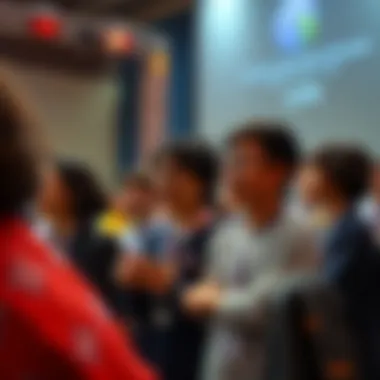Insights into the US Math Olympiad Structure and Impact


Intro
The U.S. Math Olympiad (USAMO) stands as a benchmark in the realm of mathematics competitions. Established to challenge the brightest young minds, this event is not merely a contest of skill but also a crucible for intellectual growth and educational advancement. In a landscape where traditional learning methods often fall short in fostering critical thinking and problem-solving, competitions like the USAMO carve out a niche that calls for both deep analytical thought and innovative approaches to math.
Within the pages that follow, a thorough exploration of the US Math Olympiad is laid bare, revealing its intricate structures, historical roots, and the array of strategies that participants employ in their quests for victory. Understanding this Olympiad goes beyond mere participation; it opens a doorway to how mathematics can be harnessed as a powerful tool for cognitive development. From the careful planning involved in preparation to the invaluable experiences gained post-competition, every aspect contributes to a broader narrative about mathematics in education.
As we plunge into the detailed examination, readers will find insights that empower students, educators, and mathematics enthusiasts alike. Engaging with the nuances of this competition means taking part in a transformative experience, one that not only nurtures mathematical talent but also shapes the future of learning within the educational landscape.
Key Research Findings
Overview of Recent Discoveries
Recent research indicates that participants in high-level mathematics competitions, such as the USAMO, tend to develop superior problem-solving skills and increased mathematical creativity. These findings highlight the direct correlation between competitive engagement and academic achievement in mathematics. A study published by the American Mathematical Society reveals that students involved in Olympiad-style competitions significantly outperform their peers in standardized math tests.
Moreover, many past participants have noted that their involvement led to a greater appreciation for mathematics as an art form, alongside its practical applications. This shift in perspective is vital, as it not only strengthens students’ resolve but also motivates them to explore advanced topics often overlooked in conventional curricula.
Significance of Findings in the Field
The implications of these findings extend beyond individual development. As educators incorporate competitive mathematics into their programs, the overall quality of math education could see improvements. Schools that support participation in math competitions foster environments that encourage teamwork, resilience, and a growth mindset.
This approach not only enhances students' skills but also prepares them for future challenges in various fields that demand sharp analytical abilities. To build a robust mathematical foundation, instructors must recognize the value of competitions like the USAMO in their teaching methodologies.
Breakdown of Complex Concepts
Simplification of Advanced Theories
Understanding the mathematical theories that underpin the challenges of the USAMO can be daunting. However, breaking down complex theories into digestible components can greatly assist students in their preparation. For instance, the concept of combinatorial analysis, which may appear intimidating, can be simplified into more manageable parts through practical examples and relatable scenarios. This aids students in grasping the foundations before tackling the more rigorous applications seen in the Olympiad.
Visual Aids and Infographics
Utilizing visual aids and infographics is essential in demystifying complex mathematical ideas. Graphs, flowcharts, and various forms of data representation not only enhance comprehension but also facilitate retention. By using these tools, students can visualize the connections between different mathematical concepts, making it easier to solve intricate problems posed during the Olympiad.
To summarize, engaging deeply with the US Math Olympiad reveals a trove of opportunities for enriching mathematics education. The competition urges participants not only to display their prowess but also to cultivate their analytical skills, creativity, and collaborative efforts. Understanding this prestigious event aids in laying the foundation for future academic and professional achievements in the vast world of mathematics.
Intro to the US Math Olympiad
The US Math Olympiad holds a unique place in the landscape of mathematics competitions. It acts not merely as a contest but also as an enriching experience that promotes analytical thought and problem-solving skills among students. It’s a realm where budding mathematicians can challenge themselves, connect with peers, and gain recognition for their talents. The importance of the US Math Olympiad transcends just winning; it fuels a passion for mathematics and encourages students to delve deeper into the subject.
Definition and Purpose
The US Math Olympiad, often referred to as the USAMO, is an annual mathematics competition that showcases the profound capabilities of high school students across the nation. Its purpose is to identify and cultivate mathematical talent at a young age and to provide a platform that celebrates problem-solving. The competition serves multiple functions:
- Enhancing Critical Thinking: Contestants engage with complex mathematical concepts that challenge their understanding, requiring innovative approaches to reach solutions.
- Building a Community: The Olympiad brings together students, coaches, and educators, creating a network of like-minded individuals who share a zeal for mathematics.
- Nurturing Future Talent: Participants often go on to pursue careers in STEM fields, thanks in part to the skills and self-confidence gained through competing.
Ultimately, the USAMO cultivates not just competitors, but future leaders in mathematics and related fields.
Historical Context
Tracing back to its inception in the 1970s, the US Math Olympiad was established in response to a global movement recognizing the vital importance of fostering mathematical abilities among high school students. Initially a modest gathering, its evolution over the years reflects an increased commitment to recognizing and nurturing young mathematical talent.
- The First Competition: The inaugural competition was held in 1972, marked by a small group of passionate individuals who valued mathematics education.
- Growth and Development: As the competition gained traction, it began attracting wider participation, leading to a more structured format. By integrating a different selection mechanism, it increasingly included students from diverse backgrounds.
- International Representation: Over the years, the USAMO has become a stepping-stone for students hoping to represent the United States in international competitions, such as the International Mathematical Olympiad (IMO).
"Mathematics is not about numbers, equations, computations, or algorithms: it is about understanding." – William Paul Thurston
Today, the US Math Olympiad stands as a beacon for mathematical excellence, aligning itself with educational goals that encourage inquiry and intellectual curiosity. Its historical significance continues to play a crucial role in shaping mathematics education, fostering an environment where inquisitive minds thrive.
Structure of the Competition
Understanding the structure of the competition is paramount for any aspirant hoping to compete in the US Math Olympiad. It provides clarity on what to expect and how to strategize effectively. The competition consists of several rounds, each designed to test different mathematical competencies, and the type of problems presented can greatly influence preparation methods. Knowing these elements not only underscores the significance of the competition but also assists competitors in honing their skills in targeted areas.
Overview of Rounds
During the US Math Olympiad, participants experience a series of rigorous rounds, each meant to challenge their problem-solving skills and mathematical reasoning. Starting with the American Mathematics Competitions (AMC 10 and AMC 12), students engage in a preliminary assessment consisting of multiple-choice questions. The top scorers then progress to the AIME, or American Invitational Mathematics Examination, which dives deeper into problem-solving with more complex questions, likely requiring detailed solutions rather than simple answers.
Clearing the AIME is crucial, as it serves as the gateway to the Olympiad itself. The final round, the US Math Olympiad, features six challenging problems that must be solved in a tight, three-hour window. This final stage not only accentuates critical thinking and creativity but also necessitates proficient time management. Navigating these rounds effectively can set the stage for a successful Olympiad journey.
“The rounds act like stepping stones; each one reveals the participant's growth and potential for the final challenge.”


Types of Problems
The types of problems encountered in the US Math Olympiad are distinctively crafted to cater to a high level of mathematical aptitude. The initial rounds feature a blend of topics from algebra, geometry, number theory, and combinatorics. Here’s a breakdown of what competitors can typically expect:
- Algebra: Problems may involve equations, inequalities, and functions requiring creative application of algebraic manipulation.
- Geometry: Questions often demand a robust understanding of shapes, theorems, and especially spatial reasoning.
- Number Theory: These problems test participants on divisibility, prime numbers, and various properties of integers.
- Combinatorics: Skills in counting, arrangements, and permutations play a significant role in solving these types of questions.
As competitors progress through the rounds, they become familiar with the styles and intricacies of these problems. By engaging with past Olympiad papers and rigorous practice sets, students sharpen their skills and gain insight into the problem-solving techniques that successful participants employ during the competition. This preparation phase is essential, as it can enhance not only their confidence but also their aptitude in tackling the sophisticated challenges within the Olympiad framework.
Eligibility and Selection Process
The eligibility and selection process for the US Math Olympiad (USAMO) is crucial as it establishes who can participate in this prestigious event. Understanding the criteria helps demystify the pathway for aspiring mathematicians culminating in this national competition. This section unravels who gets to hold the title of participant and how selection comes into play.
Who Can Compete?
When it comes to battling it out in the US Math Olympiad, you don’t exactly need to don a superhero cape. Instead, the basic requirements hinge largely on age and schooling. Generally, high school students are the primary focus, typically ranging from grades 9 to 12. However, the competition is open to younger prodigies as long as they haven’t reached their 20th birthday by the end of the competition year. Basically, if you have a handle on those complex calculations and can tackle those challenging problems, you’re good to go!
Here’s a quick breakdown of the eligibility framework:
- Age Limitation: Candidates must be under 20 years old by the end of the Olympiad year.
- School Level: Open to students enrolled in high school or equivalent educational institutions.
- Residency: Must be a resident within the United States or affiliated territories, which includes commonwealths and possessions.
It’s worth noting that while these are the standard prerequisites, some local competitions may have additional stipulations. Getting involved at a regional or state level can be a great stepping stone to the National Math Olympiad.
Selection Criteria
Now, stepping into the selection criteria, it’s really where the rubber meets the road. Students aspiring to showcase their talents must first navigate through several rounds of competitions – think of these as checkpoints, each one designed to sift through the wide array of mathematical minds.
The selection is generally based on performance in two main stages:
- AMC 10/12 Participation: First off, competitors need to take part in the AMC 10 or AMC 12 exams. These tests are not your average classroom quizzes; they come packed with intriguing problems that require not just rote memorization but rather a solid grasp of mathematical concepts and problem-solving abilities.
- Qualification through Scores: No doubt, the scores from these exams matter immensely. The top scorers are often invited to compete further at the AIME (American Invitational Mathematics Examination). It’s like a funnel that narrows it down, requiring students to really bring their A-game.
After the AIME, it’s the best of the best who are shortlisted for the USAMO itself. It’s a rather rigorous and competitive selection process, ensuring that those who make the cut are indeed the cream of the crop.
To sum it up, in the ever-evolving landscape of mathematics competitions, eligibility and selection are not just administrative hurdles; they are integral in shaping the environment of excellence expected in the US Math Olympiad. Knowing the criteria helps students strategically plan their approach and prepares them for the exciting challenges ahead.
Preparation Strategies
Preparation for the US Math Olympiad is not merely a matter of sitting down with textbooks and working through problems. It's a blend of strategy, resourcefulness, and targeted practice that shapes a participant’s success in this prestigious competition. A thorough preparation plan helps students not just to tackle challenging problems but also to cultivate a mathematical mindset that serves them well beyond the Olympiad.
A well-crafted strategy will encompass both the cognitive and practical aspects of learning. By prioritizing quality resources, establishing effective study habits, and understanding the nuances of problem-solving, participants can significantly enhance their performance. The objective is to transform the tedious process of studying into an intriguing journey through the world of mathematics.
Recommended Study Resources
Selecting the right study materials is crucial, akin to choosing the best tools for an intricate craft. The resources available are abundant, yet not all are equally effective. Here are some recommended materials that would be fruitful for any aspiring contestant:
- Competition Books: Texts such as "The Art and Craft of Problem Solving" by Paul Zeitz and "Mathematical Olympiad Challenges" by Titu Andreescu provide a solid foundation and insights into problem-solving techniques.
- Online Platforms: Websites like Art of Problem Solving (AoPS) and Brilliant.org offer interactive problems and courses of varying difficulty levels that are invaluable for mastering concepts.
- Past Olympiad Papers: Looking over problems from previous competitions can provide a feel for the exam's difficulty and format. Participants can often find compilations of past problems online, which serve as excellent practice material.
- Study Groups: Engaging with a group of like-minded individuals can bolster understanding and create a vibrant environment for sharing ideas. It’s often said, "Two heads are better than one," and this holds true in mathematics.
Incorporating these resources into a study regimen offers a structured approach that can cater to various learning styles.
Practice Techniques
When it comes to practice, the quality of methods used can be a game-changer. Here are some effective techniques participants can employ to sharpen their skills:
- Timed Mock Tests: Simulating exam conditions by taking timed mock tests can help participants get accustomed to the pressure of the actual competition. It also aids in assessing problem-solving speed and accuracy.
- Different Problem Types: Exposure to a variety of problem types is essential. By practicing geometry, algebra, combinatorics, and number theory problems, participants broaden their skillset and enhance their adaptability.
- Reflection and Analysis: After solving problems, it’s important to reflect on the approach taken. Analyzing mistakes helps in identifying weak areas that need more focus. This self-reflection is a powerful tool in learning.
- Regular Review Sessions: Revisiting topics periodically can enhance retention. Regularly scheduled reviews help solidify understanding, making it easier to recall information under pressure.
Adhering to these practices can significantly elevate one's problem-solving proficiency, ensuring that students arrive at the competition not just prepared but confident in their abilities.
"Success in mathematics is not about memorizing formulas but about understanding concepts deeply."
Common Challenges Faced by Participants
The US Math Olympiad is a fiercely competitive arena where the brightest young minds come to test their mettle. Participating in such a high-stakes event can be a double-edged sword: it offers a platform for showcasing talent but also brings a slew of challenges that can trip up even the most prepared students. Understanding these hurdles is not just beneficial for competitors; it’s crucial for educators and mentors who seek to guide and support their students effectively.
Difficulty Levels of Problems
One of the primary challenges contestants face is the varying difficulty of the problems presented during the competition. The problems can range from straightforward to bafflingly complex, often incorporating advanced concepts that most students might not have tackled in their regular classes. Some math whizzes might find themselves breezing through the easier questions only to become stumped by a particularly tricky one that requires not only mathematical skill but also creativity and lateral thinking.
Common Problem Types


- Geometry: Can involve intricate diagrams and clever reasoning, often requiring participants to visualize shapes and angles in unique ways.
- Number Theory: Problems that ask for unique properties of numbers can trip up even experienced competitors.
- Combinatorics: Here, students must find ways to count or arrange objects, which can become quite convoluted under pressure.
“The key to success lies in recognizing the patterns and inherent relationships within problems.”
From discussing difficulty, it’s essential to note that not every participant prepares the same way. For some, years of rigorous study equip them to tackle advanced topics effortlessly, while others may rely on intuition. This variance often leads to discrepancies in performance that can be both frustrating and enlightening.
Time Management Issues
Equally crucial to problem-solving prowess is the skill of time management. With the clock ticking down, the pressure mounts as participants must not only solve problems but do so efficiently. This aspect of the competition can turn even well-practiced students into during the event.
- Practice with Timing: Many competitors find that running through mock exams while consciously tracking their time helps. It’s one thing to solve problems, another to do so within a strict time frame.
- Prioritization: Deciding which problems to tackle first can be a game-changer. Contestants often need to gauge their strengths and weaknesses on the fly, choosing to solve easier problems for quick points while reserving more time-consuming ones for later.
The balance of pressure and time is a constant tightrope walk. Learning to manage such dynamics can directly influence a participant's confidence level and success rate. For those looking to nail their performance, embracing these challenges head-on and knowing how to navigate them is imperative.
Impact on Math Education
The impact of competitive mathematics, specifically the US Math Olympiad, on the educational landscape cannot be overstated. This prestigious event not only serves as a platform for talented young mathematicians but also plays a pivotal role in shaping how mathematics is taught and perceived in educational institutions. By encouraging critical thinking, problem-solving, and a deeper understanding of mathematical concepts, the Olympiad has become a cornerstone in promoting excellence in math education.
Encouraging Mathematical Thinking
The importance of fostering mathematical thinking is one of the greatest gifts that the US Math Olympiad leaves behind. Unlike traditional classroom settings, where rote memorization often reigns supreme, the emphasis is laid on understanding, reasoning, and applying mathematical concepts in novel ways.
By engaging students with complex problem-solving tasks, the Olympiad pushes them to think outside the box. For instance, consider a problem that requires the application of multiple mathematical principles together. Engaging with such tasks challenges students to identify connections between different areas of mathematics, thereby solidifying their conceptual understanding.
Furthermore, this event cultivates a growth mindset in participants, emphasizing that mastery comes from effort and persistence. This shift in perspective encourages students to embrace challenges rather than shy away from them, marking a significant departure from conventional educational practices that often focus heavily on grading and standardized testing.
This transformation in thought processes is crucial, as it prepares students for real-world scenarios that require logical reasoning and creative problem-solving.
Influence on Curriculum Development
Curriculum development in mathematics education is heavily influenced by competitions like the US Math Olympiad. As educators observe students engaging with higher-level problems, there is a call for curriculum shifts that reflect the needs of students who aspire to excel in such competitions.
For example, many schools have responded by integrating more challenging topics into their math curricula, including combinatorics, number theory, and advanced geometry. This move serves two purposes: first, it prepares students for the rigors of the Olympiad, and second, it enriches the overall learning experience. The nature of problems presented in the Olympiad often highlights areas that are either underrepresented or entirely absent in standard curricula.
Moreover, this competition has prompted educators to employ innovative teaching strategies that focus on discovery and inquiry-based learning rather than mere knowledge transmission. Students are encouraged to explore mathematical concepts through projects and collaborative work, enhancing their engagement and reinforcing their understanding. The idea is not just to teach mathematics but to ignite a passion for inquiry and exploration in the minds of young learners.
To summarize, the significance of the US Math Olympiad goes far beyond the competition itself; it is intrinsically linked to improving mathematics education on multiple levels. By encouraging mathematical thinking and influencing curriculum development, it fosters a generation of thinkers who are well-equipped to tackle both academic and real-world challenges.
Case Studies of Successful Participants
The landscape of the US Math Olympiad is marked by impressive individuals who have not only excelled in the competition but have also leveraged their experiences to forge impactful careers. Examining these case studies offers deep insights into what makes a successful participant and the broader implications for aspiring mathematicians. These stories are not just about winning; they're lessons in perseverance, strategic thinking, and the pursuit of excellence.
Notable Alumni
When one reflects on the notable alumni of the US Math Olympiad, several well-known names come to the forefront. For instance, a renowned figure who participated in the Olympiad is Russian mathematician Alexei Borodin. His prowess was evident early on, and he achieved a gold medal during his tenure, which paved the way for a prestigious academic career.
Another example worth mentioning is Maryam Mirzakhani, a recipient of the Fields Medal, who also had roots in mathematical competitions similar to the Olympiad. These individuals exemplify how participation in the Olympiad can serve as a springboard into remarkable endeavors—be it in academia, tech, or research.
The benefits of diving into their journeys highlight several key elements:
- Networking Opportunities: Many alumni recount how their connections formed during the competition have led to collaborative ventures and joint academic projects.
- Resilience Building: Facing tough problems in a high-pressure environment fosters resilience, a trait that particularly distinguishes Olympiad participants in their future endeavors.
- Skill Development: Participants often point out that the problem-solving skills honed during the competition translate well into real-world scenarios, particularly in STEM fields.
Career Paths after the Olympiad
The career paths taken by successful participants often reveal a common thread of passion for mathematics and its application in varied domains. Many opt for advanced studies, becoming leaders in academia or influential researchers. For example, after his tenure at the Olympiad, a prominent alum went on to contribute to artificial intelligence research, showcasing the intersection of mathematics and technology.
Beyond academia, many individuals find success in industries such as finance, where quantitative skills are paramount. Others venture into software development, algorithm design, and data analysis, attributing their analytical thinking abilities to their experience in the Math Olympiad.
Here are several career trajectories observed:
- Academic Careers: Many pursue PhDs in mathematics or related fields, becoming professors who inspire the next generation.
- Industry Roles: Positions in tech companies or financial institutions are popular, where logical reasoning and problem-solving are highly valued.
- Entrepreneurship: Some graduates channel their mathematical skills into creating startups focused on tech solutions, harnessing data analytics to drive their products.
In summary, the case studies of successful participants illustrate that the US Math Olympiad is more than just a competition; it’s a catalyst for growth that shapes futures. Individuals build skills and networks that serve them well throughout their careers. The stories of these alum provide a wealth of knowledge for current and future participants, emphasizing the vast opportunities that arise from excelling in this prestigious event.
"Participation in the US Math Olympiad is not just about the medals—it's a life-defining experience that sets the stage for countless possibilities."
As we look to the future, understanding these narratives can empower and motivate aspiring competitors, reminding them of the potential that lies within the challenge of problem-solving.


Comparative Analysis with Other International Olympiads
Analyzing the US Math Olympiad in the context of other international competitions provides valuable insights into its uniqueness and significance. An understanding of these differences and similarities enhances appreciation for what the US Math Olympiad stands for, spotlighting its role in nourishing a broad spectrum of mathematical talent.
Differences and Similarities
When comparing the US Math Olympiad with other prestigious mathematical competitions like the International Mathematical Olympiad (IMO) or the Asian Pacific Mathematics Olympiad (APMO), several distinctions and parallels emerge.
- Structure of Competitions:
- Problem Types:
- Participation:
- Preparation and Resources:
- The IMO is held annually and involves participants from over a hundred countries, testing both individual and collaborative skills. In contrast, the US Math Olympiad prioritizes the individual competitor's prowess and encourages unique problem-solving approaches.
- Problems in the IMO tend to cover a wider array of mathematical topics and often include multi-disciplinary approaches. The US Math Olympiad, although demanding and intricate, typically focuses on algebra, combinatorics, geometry, and number theory.
- The IMO invites representatives from national teams, whereas the US Math Olympiad is more of an open competition, allowing a wider range of participants, including those not affiliated with any formal training institutions.
- Preparation for the IMO often entails national training camps and formal coaching, whereas students prepping for the US Math Olympiad may rely on personal study and guidance from peers or educators.
Despite these differences, the essence of fostering mathematical talent remains constant across all competitions. Each one aims to cultivate critical thinking, logical reasoning, and creativity in problem-solving. This goal is paramount in today’s education landscape where adaptability and analytical skills take center stage.
Participants' Experiences
Participants in the US Math Olympiad often share experiences that shed light on the competition's unique atmosphere.
- For many, it acts as a catalyst for personal growth. The rigorous training that precedes the competition cultivates resilience and boosts confidence—traits which are invaluable beyond the pressure of mathematics.
- The camaraderie among competitors and mentors creates a nurturing environment. Competing in the US Math Olympiad does not solely revolve around securing a top position. Instead, many find their peers become lifelong friends, fostering a community that shares a passion for mathematics and learning.
- Moreover, participants often recount how exposure to high-level problems shapes their approach toward math in general. They learn to embrace challenges, which, in turn, turns their passion into a more profound understanding of mathematical concepts.
"What started as a competition transformed into a collaborative journey of discovery. I learned as much from my peers as I did from the problems."
Such testimonies highlight how competitors immerse themselves in the rich experience provided by the US Math Olympiad, gaining insights not just into math, but into teamwork, resilience, and a deep-seated love for the subject.
Future of the US Math Olympiad
The future of the US Math Olympiad holds significant importance, as it reflects ongoing developments within mathematics education and the evolving needs of students. As the competition embraces technological advancements and pedagogical shifts, understanding these elements will be crucial for participants, educators, and stakeholders in mathematics education.
Trends in Mathematics Education
When we look at trends in mathematics education, several key shifts stand out. One prominent trend is the increasing integration of technology in the learning process. Students are now exposed to coding and computational thinking at an earlier age. This can transform traditional problem-solving approaches. For instance, using platforms like Khan Academy or Brilliant allows students to engage with interactive math problems, reinforcing their skills.
In addition, there's a growing emphasis on collaborative learning. Students are not just solitary problem solvers any longer; they often work in groups to tackle complex problems, mirroring real-world scenarios. This kind of teamwork fosters critical thinking and could provide an edge in competitions like the Olympiad. Moreover, educators across the country are advocating for a curriculum that balances both theoretical and practical aspects of mathematics.
Furthermore, the trend of personalized learning is also on the rise. Learners can now follow unique pathways in their education. This could mean intensified focus on specific areas such as algebra or combinatorial geometry, which are pivotal subjects in the Olympiad. Such personalized approaches might impact how future Olympiads are structured and the types of problems presented.
Potential Changes in Competition Format
As for potential changes in the competition format, several ideas have surfaced among educators and current participants. One possibility is the inclusion of digital formats for some sections of the competition. Given that students are increasingly familiar with online testing environments, this could make the competition more accessible to a wider audience.
Additionally, incorporating more real-world applications into problems could provide an engaging twist. For example, instead of traditional geometric problems, participants might face scenarios involving data analysis or mathematical modeling related to climate change or urban planning. Such changes could attract a more diverse group of competitors, encouraging holistic mathematical thinking.
Moreover, as the landscape of education evolves, flexibility in the competition schedule might be necessary. Possible adaptations could include more rounds and variations in difficulty levels, accommodating diverse skill sets among participants.
"The success of the US Math Olympiad will largely depend on its ability to adapt to the shifting landscape of mathematics education and the diverse needs of students across the country."
The emphasis on inclusivity and relevance in mathematics will certainly shape future iterations of the Olympiad. By examining these ongoing trends, stakeholders can anticipate and prepare for pivotal changes that will define the competition in the coming years.
The End
In wrapping up our exploration of the US Math Olympiad, it's clear this event carries significant weight in the landscape of mathematics education. The competition is not just a test of knowledge; it’s a testament to what rigorous problem-solving and critical thinking can achieve. By participating, students develop skills that are invaluable in both academic and real-world settings.
Summary of Key Points
Throughout the article, several salient points have emerged:
- Historical Significance: The US Math Olympiad has a storied past, showcasing the evolution of mathematical competitions in the country. Its inception marked a pivotal moment for nurturing young mathematical talent.
- Competitive Structure: The Olympiad's format, with its specific rounds and types of problems, is designed to challenge participants deeply, encouraging them to think creatively and logically.
- Impact on Education: The direct influence of the Olympiad on mathematics curricula has expanded the scope of how mathematics is perceived and taught in schools, prompting educators to focus on deeper conceptual understanding rather than rote memorization.
- Preparatory Strategies: Understanding effective study techniques and resources can significantly enhance a participant's chance of success. Emphasis on practical practice and engaging with challenging problems prepares competitors for the rigors of the event.
- Future Directions: As trends in mathematics education evolve, so too must the Olympiad adapt, ensuring it remains relevant and constructive for aspiring mathematicians.
Final Thoughts on Mathematics Competitions
Mathematics competitions, particularly the US Math Olympiad, are vital for fostering a culture of excellence in mathematics among students. They not only stimulate interest in the subject but also help in developing a rich skill set that extends beyond the classroom.
Participating in such competitions teaches resilience. Students learn to cope with failure and derive valuable lessons from it, as every problem they encounter serves as a stepping stone to mastering more complex concepts.
In closing, the journey through competitions like the US Math Olympiad is more than a pursuit of medals or accolades. It's about honing a way of thinking that can serve individuals throughout their lives, irrespective of the profession they choose. Mathematics teaches us to approach problems systematically, a skill in high demand in any field. Therefore, as educators, students, and mathematical enthusiasts, we should champion these competitions.
"Mathematics is, in its own way, a form of art — one that encourages intellect, creativity, and personal growth."
So, the road ahead appears bright for both enthusiasts and the future of mathematics education, illuminating avenues for discovery, learning, and growth.















